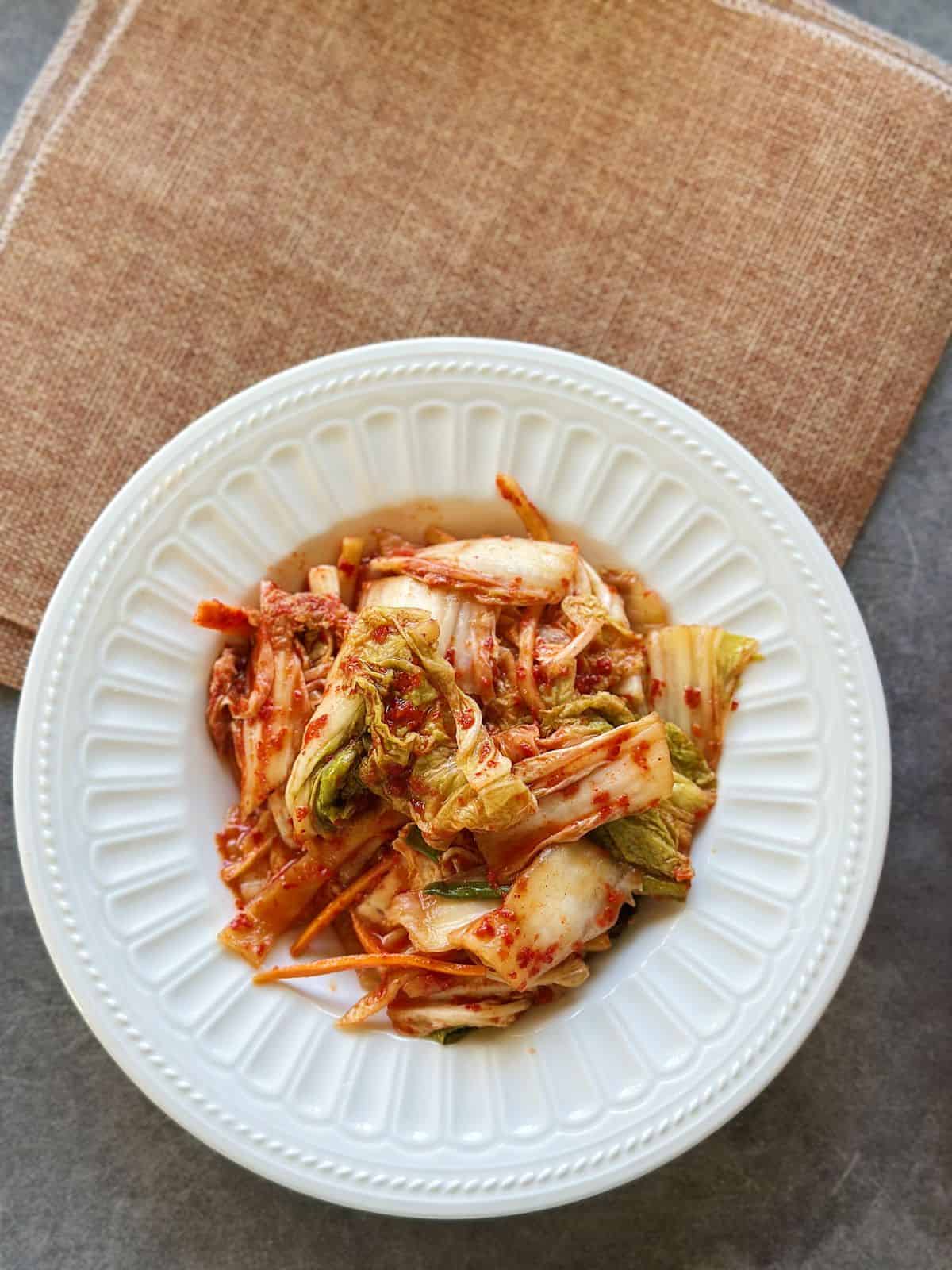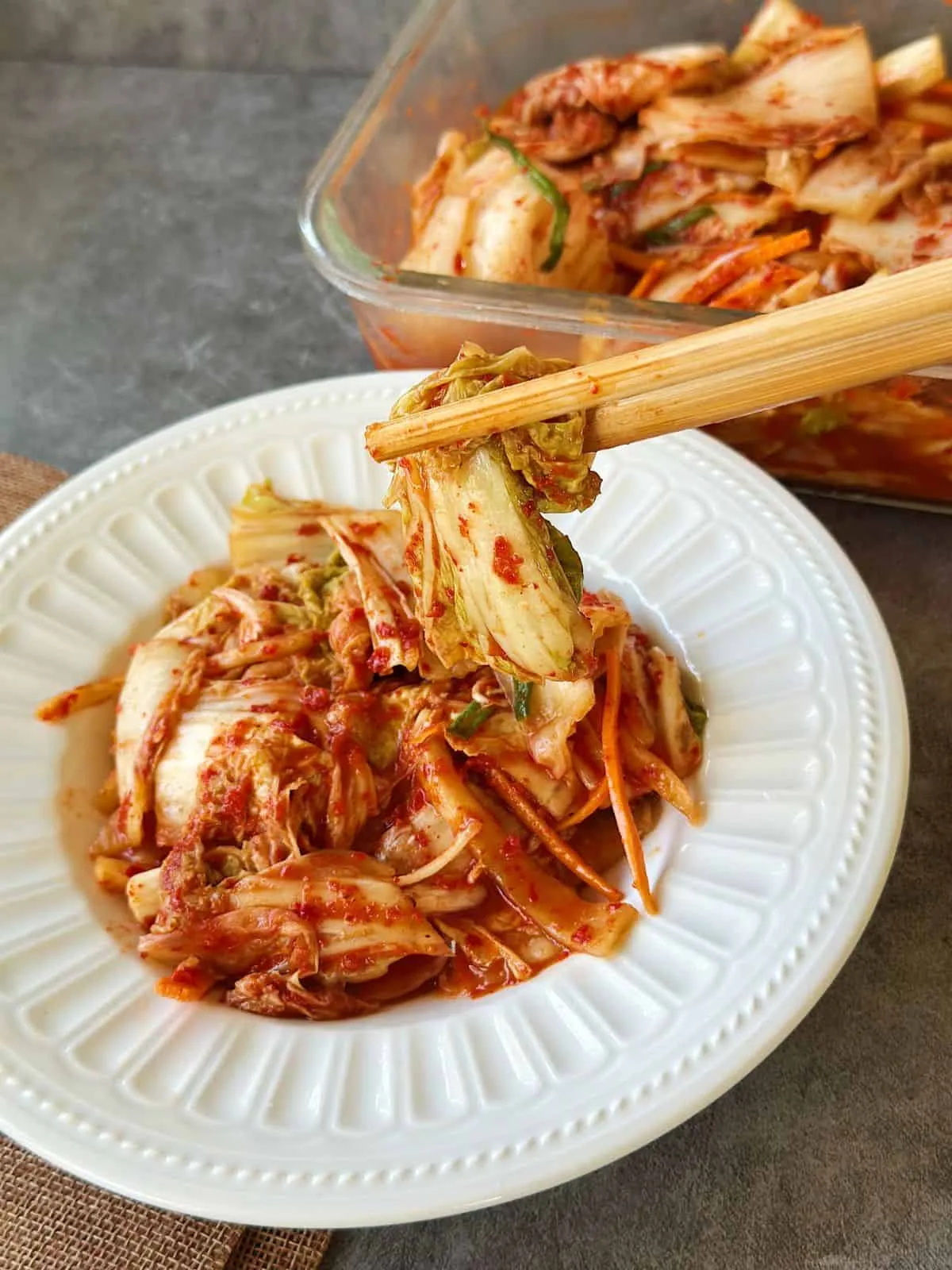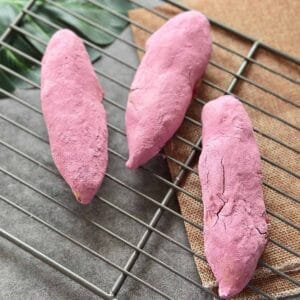Kimchi – Korea’s iconic fermented dish – comes in countless variations, but the star is Baechu Kimchi with Napa cabbage. Bold, authentic, and surprisingly easy to make right at home.

What’s Inside
What Is Kimchi?
Kimchi is a cornerstone of Korean cuisine – a tangy, punchy side dish made from salted and fermented vegetables, most commonly Napa cabbage or Korean radish.
It’s flavored with aromatics like garlic, ginger, scallions, and a bit of jeotgal (salted seafood) for that deep umami flavor.

Most kimchi varieties are known for their vibrant red color, thanks to gochugaru (Korean chili flakes). But not all kimchi is spicy – take mul kimchi, for example. This “water kimchi” is light, cooling, and perfect for warmer days.
Fermented and pickled veggies are something we love across Asia.
In Vietnam, we have Đồ Chua (pickled carrot and daikon) and Dưa Muối (fermented mustard greens). That tangy freshness is the perfect balance to rich dishes like Thịt Kho Trứng or Cá Kho.
What Does Kimchi Taste Like?
Kimchi is bold and full of personality – spicy, tangy, and packed with umami. Its flavor changes over time, depending on what goes into it and how long it ferments.
When freshly made, baechu kimchi is crisp and slightly sour – super refreshing as a side dish.
As it ferments, the flavor gets deeper, funkier, and more intense – just what you want for comforting dishes likekimchi jjigae(kimchi stew).
Ingredients
In Korea, kimchi isn’t just food – it’s tradition. During summer, it’s common to make small, fresh batches with whatever vegetables are in season.
But when autumn rolls around and the air gets crisp, families and neighbors gather for Kimjang – a special event where big batches of kimchi are made to carry everyone through the cold winter months.
To give kimchi more depth, many people prepare a flavorful “broth” with umami-rich ingredients like kombu, dried fish, or salted shrimp (saeu-jeot).
But today I’m sharing a much simpler version. A small-batch recipe you can make at home, with ingredients that are easy to find and work beautifully together.
Key Ingredients
- Napa Cabbage – The star of traditional Baechu Kimchi.
- Sea Salt (or Coarse Salt) – Helps draw out moisture from the cabbage so it stays crisp and ferments properly.
Kimchi Paste

- Glutinous Rice Flour – Thickens the paste and helps it cling to the cabbage. If you don’t have it, feel free to use regular rice flour or even some plain steamed rice.
- Fish Sauce – Brings in that deep, savory umami. I personally love using a good-quality Vietnamese fish sauce for this.
- Sugar – Just a touch helps kickstart fermentation.
- Korean Pear – Naturally sweet and juicy, it tenderizes the cabbage and balances out the spice. No pear? An apple, kiwi, or even a regular pear will do the trick.
- Gochugaru (Korean Chili Flakes) – This gives kimchi its gorgeous red color and gentle heat. Adjust the amount to your liking.
- Aromatics – Garlic, onion, and ginger bring bold, fragrant flavors that make kimchi so addictive.
Additional Veggies
- Scallions (or Chives) – Bring a light, fresh onion flavor that brightens up the kimchi.
- Korean Daikon (or regular daikon, red radish) – Adds a crisp bite and a hint of natural sweetness.
- Carrot – Gives the kimchi extra crunch and a pop of vibrant color.
Instructions
Preparing the Napa Cabbage
- Cut the Napa cabbage into quarters. Tip: First, make a small cut at the base, then gently pull it apart with your hands to keep the leaves intact.
- Generously rub salt between all the leaves, paying extra attention to the thicker stems. Let the cabbage sit for about 8 hours, flipping it halfway through (after 4 hours). It’s ready when the leaves become soft and flexible without breaking.
- Rinse the cabbage thoroughly several times to remove excess salt. Tip: Taste a small piece to check the saltiness.
- Gently squeeze out excess water and let the cabbage drain in a sieve for about 30 minutes.


Preparing the Kimchi Paste
- Mix glutinous rice flour with water and cook over medium heat until it thickens. Alternatively, microwave it for 1.5 minutes, stirring once in between.
- Wash and peel the Korean pear, daikon, carrot, onion, garlic, and ginger.
- Cut the daikon and carrot into matchstick-sized pieces. Chop the spring onions into 4 cm (1.5-inch) pieces.
- Blend the pear, onion, garlic, ginger, cooked rice, and fish sauce with a little water until smooth.
- Combine the blended mixture with gochugaru (Korean chili flakes), daikon, and carrots to create a flavorful kimchi paste.


Mixing and Fermenting
- Cut the cabbage into bite-sized pieces.
- Gently mix it with the kimchi paste, ensuring all the leaves are well coated.
- Transfer the kimchi into a glass jar and let it ferment at room temperature:
- In summer: 12–24 hours
- In winter: 1–2 days
- Store in the refrigerator after fermentation to extend its shelf life.


Expert Tips
1. Choose the right napa cabbage.
Pick cabbages with tender leaves, soft stems, and a rounded, heavy shape. The color should gently fade from pale green at the tip to whitish near the base. A firm and heavy cabbage is a good sign.
2. Salt properly.
Always use coarse sea salt and avoid iodized salt (it can interfere with fermentation). After salting, rinse the cabbage thoroughly to wash away excess salt.
3. Use rice porridge for the paste.
A starchy base helps fermentation and keeps the seasoning paste sticking nicely to the cabbage. You can use rice flour, sticky rice flour, or even steamed rice (regular or sticky). Some people try wheat flour or tapioca starch too, though I haven’t tested those myself.
4. Add natural sweetness.
Korean kimchi often includes pear or apple for balance. You can also substitute with kiwi or ripe persimmon.
5. Boost umami.
Besides fish sauce and salted shrimp (saeujeot), you can experiment with Vietnamese shrimp paste (mắm tôm or mắm ruốc) for a deeper savory kick.
6. Vegan option.
Swap fish sauce for soy sauce or miso paste to keep it plant-based while still flavorful.
7. A little cheat.
Adding a spoonful of gochujang to your kimchi paste can “cheat” the process—it speeds up fermentation and gives extra depth.
8. Korean ‘New Sugar.’
In Korea, many recipes mention “new sugar” (뉴슈가 / nyu syuga), a sodium saccharin–based sweetener that helps kimchi stay sweet without over-fermenting. If you don’t want to use it, just stick with regular sugar or add a touch of MSG for balance.
9. Quick Korean Tip for Using Kimchi
- Fresh or lightly fermented kimchi → Best enjoyed raw: as a side dish (banchan), in salads, with noodles (bibim guksu), or as a wrap with grilled pork belly (samgyeopsal, bossam).
- Aged or sour kimchi → Perfect for cooking: use it in stews (kimchi jjigae), fried rice (kimchi bokkeumbap), dumplings, stir-fries, or savory pancakes (kimchi jeon).
More Tasty Korean-Inspired Recipes

The Easiest & Simplest Kimchi Recipe
Ingredients
Main Ingredients
- 2 Napa cabbages (3–4.5 lbs/1.5-2kg)
- ½ cup sea salt (130g)
- 3.5 oz daikon radish (~1 cup/100g) cut into matchsticks
- 3.5 oz carrot cut into matchsticks
- 4 scallions cut into 1.5-inch pieces
Rice Paste
- ½ cup water (120g)
- 2 tsp glutinous rice flour (or regular rice flour) (10g)
- 1 tsp granulated sugar (5g)
Kimchi Sauce
- 1.75 oz garlic, peeled (50g) about 3-4 cloves
- 1.75 oz onion, peeled (50g) about ¼ medium onion
- 1.75 oz Korean pear (or pear, apple, kiwi), (50g) about ⅓ pear, peeled and cored
- 1.75 oz fish sauce (50g/3.5 tbsp)
- 1.75 oz gochugaru (Korean chili flakes) (50g) to taste, up to ½ cup (2.8oz/80g)
- 0.35 oz ginger (10g) peeled
Instructions
Preparing the Napa Cabbage:
- Cut the Napa cabbage into four pieces. Tip: First, make a cut at the base and then gently pull apart the leaves with your hands to keep them intact.
- Generously sprinkle salt on all the leaves, especially on the thicker stem. Let the cabbage rest for 8 hours, flipping it after 4 hours. It’s ready when it becomes flexible and bends easily without breaking.
- Rinse the cabbage thoroughly with water to remove excess salt. Tip: Taste a small piece to check the saltiness.
- Gently squeeze out excess water and let the cabbage drain in a colander for about 30 minutes.
Preparing the Kimchi Paste:
- Mix glutinous rice flour with water and cook over medium heat until it thickens. Alternatively, you can heat it in the microwave for 1.5 minutes, stirring once.
- Blend the pear, onion, garlic, ginger, cooked rice, and fish sauce with a bit of water until smooth.
- Combine the paste with gochugaru (Korean chili flakes) and the sliced daikon and carrot matchsticks to create a fragrant kimchi mixture.
Fermenting:
- Cut the cabbage into small, bite-sized pieces. Carefully mix it with the kimchi paste, ensuring each leaf is evenly coated.
- Pack the kimchi into a glass jar and let it ferment at room temperature:– Summer: 12–24 hours– Winter: 1–2 days
- After fermentation, store the kimchi in the refrigerator to extend its shelf life.




